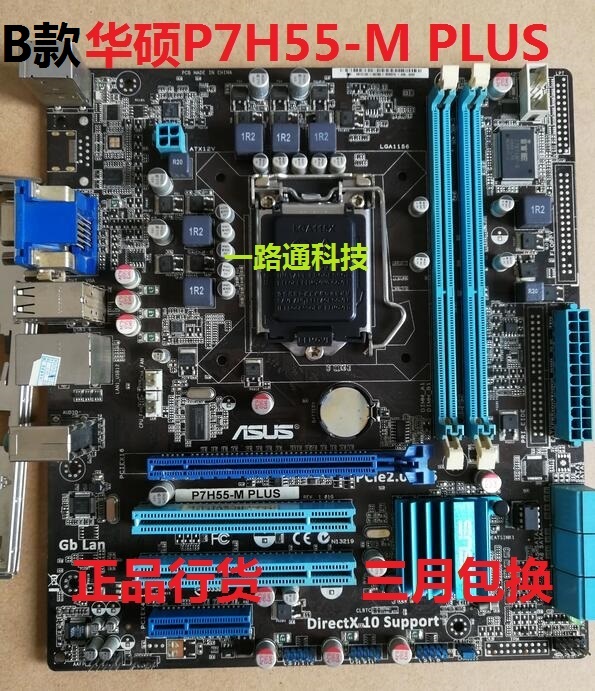

Both of these will offer more improvement. Instead focus on your drive If you haven’t already done it going to a SSHD hybrid drive or better yet a good high speed SSD. So don’t spend extra for the few nano seconds of improvement.Ĭonsider going with more than 8 GB of RAM I would go with 16 GB if you want better performance working on large items or running multiple apps concurrently. You can use the faster RAM, but, you really won’t see a sizable difference. Your MacBook was designed for PC3-10600 DDR3 SDRAM, its best to stick with what Apple expects. But thats only the modules ability not what the system is running its memory bus speed at. This is the speed of the RAM Clearly DDR3-1600 is able to run faster than DDR-1333.

PC3L RAM will work in a PC3 based system as it will run at the standard voltage and will inter-operate with PC3 RAM within the system.ġ2800 MB/s (DDR3-1600) Vs 10600 MB/s (DDR3-1333)
#Asus p7h55 with pc3 10600 memory pro
P7H55-MPRO-540 ASUS P7H55-M PRO Socket LGA 1156 Intel H55 Chipset Core i7 / i5 / i3 Processors Support DDR3 4x DIMM 6xSATA 3.0Gb/s Micro ATX Motherboard. PC3 is standard voltage (1.50V) where PC3L is low voltage (1.35V) - A system which requires PC3L cannot support PC3 RAM. Supported Memory Standard(s) PC3-10600 (DDR3-1333) PC3-8500 (DDR3-1066) Maximum Installed Memory: 16 GB: Expansion Slots: PCI-E 2.0 x1 PCI-E 2.0 x16: Storage Controller: SATA 3.0 Gbps. Mahalo's-n-aloha's to all.Lets breakdown the different elements in the modules description: It's getting late here in Hawaii so unless you don't have a life, I won't anticipate a reply tonight.Īny help is fantastically appreciated. So now I have 2 hdwe issues rather than 1. These HDD's were IDE and I scored some IDE to SATA adapters and made all the connections, but apparently something is wrong. Since I was in the BIOS, I went into the "Boot" menu and made changes to the "boot device priority", and was alarmed to see that 2 of the HDD's were not recognized, 1 of which has the OS loaded. Prior to booting up with the PCI-E card, I hooked up the remaining 3 HDD's. However, I then powered down and changed the mobo cable from the PCI-E card to the mobo VGA connection and booted up.to a blank screen with the same prior message of "1d-sub no signal". I cockroached (Hawaiian slang for procured) a PCI-EX16 video card from a techie friend and was able to enter the BIOS and change the "chipset>uncore configuration>initiate Graphic Adapter" and changed the Lynnfield CPU config to PCI/PCIE. Many mahalos-n-aloha from the big Island of Hawaii, Nothing said about possibly giving me some guidance as to mobo jumpers or some other type of error I might have made. I've contacted ASUS tech help and they suggested I purchase either a new CPU or a new graphics card. When powered up the monitor displays a small screen saying "1 d-sub - no signal". The monitor's On-Board Display was set to make VGA as the default signal mode. The VGA cable and monitor were tested on another system immediately prior to hooking them up to the new system. This monitor has both VGA and DVI-D (dual link) connections. I hooked up a NEC AccuSync LCD92VX monitor. The MOBO has both VGA and DVI-D (dual link) on-board video connections.

I installed the HD with the OS WINXPSP3-home on it, No other HD's or Optical drives or PCI cards have yet been installed. The system came with 2GB of DDR3-1333 (PC3-10600) RAM and I added another 2GB of the same memory. The system came with an ASUS P7H55-M LX mobo, to house the Intel Core i5 760 (4 x 3.33GHz CPU - 8MB Cache) I ordered as an upgrade. I recently purchased a bare bones system from an online e-tailer.


 0 kommentar(er)
0 kommentar(er)
